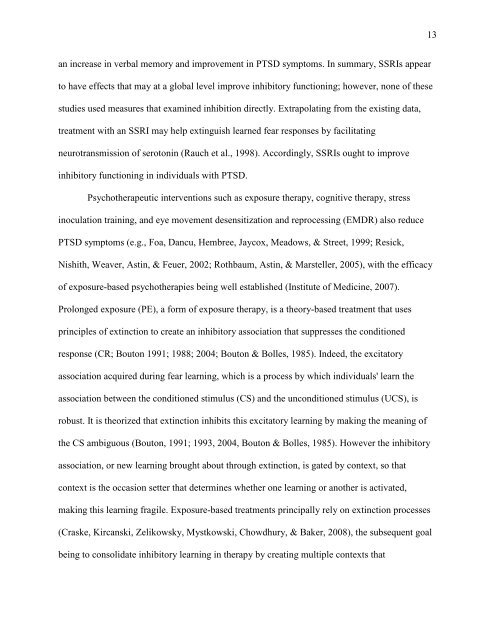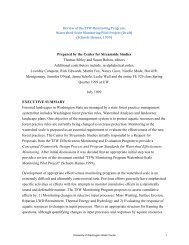Copyright 2012 Aileen M. Echiverri-Cohen - University of Washington
Copyright 2012 Aileen M. Echiverri-Cohen - University of Washington
Copyright 2012 Aileen M. Echiverri-Cohen - University of Washington
You also want an ePaper? Increase the reach of your titles
YUMPU automatically turns print PDFs into web optimized ePapers that Google loves.
an increase in verbal memory and improvement in PTSD symptoms. In summary, SSRIs appear<br />
to have effects that may at a global level improve inhibitory functioning; however, none <strong>of</strong> these<br />
studies used measures that examined inhibition directly. Extrapolating from the existing data,<br />
treatment with an SSRI may help extinguish learned fear responses by facilitating<br />
neurotransmission <strong>of</strong> serotonin (Rauch et al., 1998). Accordingly, SSRIs ought to improve<br />
inhibitory functioning in individuals with PTSD.<br />
Psychotherapeutic interventions such as exposure therapy, cognitive therapy, stress<br />
inoculation training, and eye movement desensitization and reprocessing (EMDR) also reduce<br />
PTSD symptoms (e.g., Foa, Dancu, Hembree, Jaycox, Meadows, & Street, 1999; Resick,<br />
Nishith, Weaver, Astin, & Feuer, 2002; Rothbaum, Astin, & Marsteller, 2005), with the efficacy<br />
<strong>of</strong> exposure-based psychotherapies being well established (Institute <strong>of</strong> Medicine, 2007).<br />
Prolonged exposure (PE), a form <strong>of</strong> exposure therapy, is a theory-based treatment that uses<br />
principles <strong>of</strong> extinction to create an inhibitory association that suppresses the conditioned<br />
response (CR; Bouton 1991; 1988; 2004; Bouton & Bolles, 1985). Indeed, the excitatory<br />
association acquired during fear learning, which is a process by which individuals' learn the<br />
association between the conditioned stimulus (CS) and the unconditioned stimulus (UCS), is<br />
robust. It is theorized that extinction inhibits this excitatory learning by making the meaning <strong>of</strong><br />
the CS ambiguous (Bouton, 1991; 1993, 2004, Bouton & Bolles, 1985). However the inhibitory<br />
association, or new learning brought about through extinction, is gated by context, so that<br />
context is the occasion setter that determines whether one learning or another is activated,<br />
making this learning fragile. Exposure-based treatments principally rely on extinction processes<br />
(Craske, Kircanski, Zelikowsky, Mystkowski, Chowdhury, & Baker, 2008), the subsequent goal<br />
being to consolidate inhibitory learning in therapy by creating multiple contexts that<br />
13
















